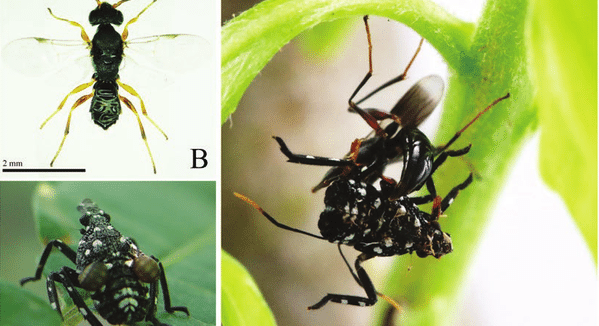As lanternflies continue spreading throughout New York state — despite calls for them to be stomped on sight — researchers are weighing the introduction of the invasive insect’s nemesis from overseas.
Dryinus sinicus, also known as the Dryinidae wasp, is a natural predator of spotted lanternflies in China, their native habitat. U.S. Department of Agriculture researchers are in the early stages of studying whether the parasitic wasp could help control lanternflies in the United States without becoming a destructive invasive species itself.
“This is kind of a common natural enemy,” said Julie Urban, an evolutionary biologist at Penn State University. “With as good of a job as they’re doing, and knowing that this kind of thing is probably a natural control agent … this seems like a reasonable bet to me.”
Time is of the essence. Lanternflies feed on the sap of trees and other plants, making it tougher for flora to survive the winter. The polka-dotted red bugs have spread as far as the Finger Lakes, Long Island and Lake Erie, where they threaten to cause real damage to the state’s economy.
Lanternflies damage trees, grapevines and other plants.
USDA/Lance Cheung.
New York is the third-largest winemaker in the country, producing nearly 30 million gallons of wine every year. The state is also a major producer of concord grapes, used for jams and juices. Local environmental authorities have noticed that lanternflies have taken a particular liking to the sweet sap of the Empire State’s grape vines.
“When the adult lanternflies feed late in the season, they’re removing enough of the sugars and the starches that the [grape] vines are weakened, and they won’t come back in the spring,” said Brian Eshenaur, an invasive species specialist at Cornell University. “They die over the winter because their reserves are removed.”
Federal scientists have put their hopes on the solitary, parasitic Dryinidae wasp, which kills lanternflies in a gruesome fashion. The parasitic bug uses its front legs to hold onto a baby spotted lanternfly while feeding on it. The wasp also lays eggs under its victim’s wings, forming a hard protective sac on the live nymph.
The wasp’s larvae survive by eating the spotted lanternfly from the inside out until the wasp protrudes from the dead baby lanternfly. It then dumps the carcass and spins a cocoon to continue its development through the winter.
In China, Dryinidae wasps are up to 60% effective at killing juvenile spotted lanternflies.
The wasps have also proven effective in USDA labs, where they are released in a controlled environment meant to replicate Beijing’s spring climate. Scientists tempt the wasp with a buffet of insect delicacies, such as silk moths, as well as its comfort food: spotted lanternflies.
Lanternflies threaten New York state’s concord grape and wine industries.
USA/Stephen Ausmus
So far, the wasps have chowed down on the lanternflies, leading researchers to be guardedly optimistic they would not be opening Pandora’s box by releasing the wasps in the Northeast.
The tiny black wasp has already been successfully released in other parts of the world to control lanternflies.
But experts cautioned a decision on whether to unleash the wasps is still a long way off.
“This [lab testing] is going to take a long, long time because they have to do non-target testing, which takes many, many years to show that it is not a risk to other insects that it’s likely to encounter in nature,” said Kelli Hoover, entomology professor at Penn State University.
A team at Penn State is studying a different technique to end the lanternfly rampage: booby-trapped trees. Urban, the biologist at Penn State, noticed that lanternflies tend to congregate on certain trees of the same species.
She and her team are trying to figure out why. They hope to bait the lanternflies’ favorite trees – red maples – with pesticide.
“We’re trying to always build a better mousetrap for the lanternfly,” Urban said. “If we had a tree that was a really good trap that you could inject with an insecticide and put it next to a vineyard and pull the lanternfly off the grapevines, then that would be great.”
